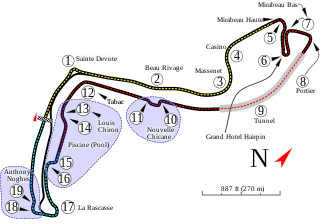
The Porsche 804 is a single-seat, open-wheeled racing car produced by Porsche to compete in Formula One (F1). It raced for a single season in 1962 in the 1½ litre formula.

British Racing Motors (BRM) was a British Formula One motor racing team. Founded in 1945 and based in the market town of Bourne in Lincolnshire, it participated from 1951 to 1977, competing in 197 grands prix and winning seventeen. BRM won the constructors' title in 1962 when its driver Graham Hill became world champion. In 1963, 1964, 1965 and 1971, BRM came second in the constructors' competition.

The 1962 Formula One season was the 16th season of FIA Formula One motor racing. It featured the 13th World Championship of Drivers, the 5th International Cup for F1 Manufacturers, and numerous non-championship Formula One races. The World Championship was contested over nine races between 20 May and 29 December 1962.
Neville Lederle was a racing driver from South Africa. He participated in two World Championship Formula One Grands Prix, scoring a single championship point.

Team Lotus was the motorsport sister company of English sports car manufacturer Lotus Cars. The team ran cars in many motorsport categories including Formula One, Formula Two, Formula Ford, Formula Junior, IndyCar, and sports car racing. More than ten years after its last race, Team Lotus remained one of the most successful racing teams of all time, winning seven Formula One Constructors' titles, six Drivers' Championships, and the Indianapolis 500 in the United States between 1962 and 1978. Under the direction of founder and chief designer Colin Chapman, Lotus was responsible for many innovative and experimental developments in critical motorsport, in both technical and commercial arenas.

The Lotus 49 was a Formula One racing car designed by Colin Chapman and Maurice Philippe for the 1967 F1 season. It was designed around the Cosworth DFV engine that would power most of the Formula One grid through the 1970s. It was one of the first F1 cars to use a stressed member engine combined with a monocoque to reduce weight, with other teams adopting the concept after its success. An iteration of it, the 49B, also pioneered the use of aerofoils to generate downforce.

The Lotus 43 was a Formula One racing car designed by Colin Chapman for the 1966 season. Hampered by its heavy and unreliable BRM engine, it won only one race, the 1966 United States Grand Prix.

The Ferrari 312 F1 was the designation of the 3 litre V-12 Formula One cars raced by the Italian team from 1966 to 1969.

The Brabham BT49 is a Formula One racing car designed by South African Gordon Murray for the British Brabham team. The BT49 competed in the 1979 to 1982 Formula One World Championships and was used by Brazilian driver Nelson Piquet to win his first World Championship in 1981.
Eric Harrison Broadley MBE was a British entrepreneur, engineer, and founder and chief designer of Lola Cars, the motor racing manufacturer and engineering company. He was arguably one of the most influential automobile designers of the post-war period, and over the years Lola was involved with many high-profile projects in Formula One, Indy car, and sports car racing. Broadley sold Lola to Martin Birrane in 1997.

The Zakspeed 841 was the first Formula One car built and raced by the German Zakspeed team for the 1985 season. Lead driver was British driver Jonathan Palmer with Formula 3000 driver Christian Danner from Germany joining the team later in the season. The 841 was designed by Paul Brown.
The Porsche 787 is a Formula One (F1) racing car built and raced by Porsche for one year in 1961.

The Cooper T81 is a Formula One car produced by the Cooper Car Company for the 1966 Formula One season. It represented something of a comeback for Cooper's fortunes, winning two races and enabling Cooper to finish third in the Constructors' Championship in 1966 and 1967.
Colin Crabbe Racing, also known as Colin Crabbe - Antique Automobiles and Antique Automobiles Racing Team, was a privateer team run by Colin Crabbe, a noted dealer in historic racing cars, that entered a single car in 17 Formula One races in 1969 and 1970. Vic Elford and Ronnie Peterson drove for the team, the cars used being a Cooper T86, a McLaren M7B and a March 701.

The Cooper T86 was a Formula One racing car built by Cooper and first raced in 1967. B and C specification cars were also built to accommodate different engines, but the car could not revive Cooper's fortunes and this type represents the last Formula One chassis built and raced by the former champion team.

The Matra MS10 is a Formula One car entered by the Matra International team during the 1968 Formula One season. It, along with its V12-powered sibling MS11, was Matra's first purpose-built F1 car and won three races in 1968, taking Jackie Stewart to second place in the Drivers' Championship and Matra International to third place in the Constructors' Championship.

The Spirit 101 was a Formula One car for the 1984 and 1985 Formula One seasons. The car was designed by Gordon Coppuck and Tim Wright.
Anthony Kotze, referred to in some sources as Anthony Kotzé, was a racing driver and racing car constructor from South Africa. He participated in four non-championship Formula One races and several sports car races, and is perhaps best known as the constructor of the Assegai, one of the only South African-built Formula One cars.

The 2016 Historic Grand Prix of Monaco was the tenth running of the Historic Grand Prix of Monaco, a motor racing event for heritage Grand Prix, Voiturettes, Formula One, Formula Two and Sports cars.














